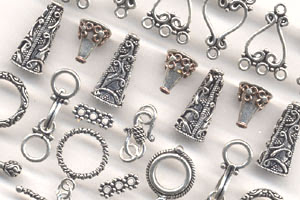Making a Brooch Using Jewelery Findings
Executive Summary about Jewelery Findings By A Hunter
 Brooches can be created very simply; buying jewellery findings such as brooch blanks and gluing stones or mosaic pieces to them. Pins can be glued to the backs of the blanks and a very basic brooch is made. A popular effect is layering. Not only does it add an intricacy to the piece, but stones can also be incorporated for eye-catching effects. Round-nosed pliers are advisable in this process to cope with minute manipulation of the wire involved.
Brooches can be created very simply; buying jewellery findings such as brooch blanks and gluing stones or mosaic pieces to them. Pins can be glued to the backs of the blanks and a very basic brooch is made. A popular effect is layering. Not only does it add an intricacy to the piece, but stones can also be incorporated for eye-catching effects. Round-nosed pliers are advisable in this process to cope with minute manipulation of the wire involved.
Firstly, you need to decide on the backing for your brooch: gold, or silver. Once you have made your choice, you will need gold or silver half-hard wire; - 0.50 mm in diameter. The hardness of these wires makes them perfect for incorporating small beads, gems or pearls into your design.
Take one continuous length and, using your round-nosed pliers, create a tine curve in one end; this will act as a seal. Form a looping circle and place your beads, stones or pearls onto the wire. Looping the wire into petal shapes, form the outline of a flower. Depending on how much wire you have, you can continue to loop petal shapes and layer them onto the petals behind, forming a succession of overlapping petals. Ensure, however that you leave enough wire free to fix a central stone or gem.
Thread the exposed wire through your chosen centrepiece and then pull it through the centre of the flower and out through the back of the piece. Once again, using the round-nosed pliers, roll the end of the wire in on itself to form a securing seal. Attaching pins, or pinbacks, can be either glued or soldered on. Soldering is an advanced technique that requires specialist equipment and is more suited to attaching clasps and other jewelery findings to denser brooch-bases, such as blanks.
Depending on the materials you have used to create your brooch, you may or may not want to seal them. All raw brass should be sealed, as it will oxidise and discolour if it is not. There are many spray lacquers available, but it should be noted that many of them create toxic fumes and should only be used in well-ventilated areas. Glass and gemstones do not need sealing, but pieces of porcelain and anything that is unglazed will require it.
What Are Jewellery Findings?
Jewellery findings are the seemingly insignificant but vitally important components of any type of jewellery making. Without crimp beads, for example, it would be difficult to get a professional looking finish to a necklace or bracelet clasp. Jewellery findings are the solution to all jewellery making techniques, and as such a good understanding of their importance in your designs and work is essential.
The most common jewellery findings - earring wires, crimp beads, eyepins, headpins and clasps - are usually made of either silver wire or sterling silver. There are a plethora of other, more specialist findings (for watchstrap projects and more costume-based accessories), but let's start with the basics.
Crimp beads should be an essential part of every jewellery maker's toolbox, especial those working with beads. These simple (usually silver) beads are used to cover knots in the thread or to secure a loop in a necklace or bracelet string, making it possible to attach a jump-ring to the loop to complete a clasp. The metal is soft and once the crimp bead is in position, a pair of flat-nosed or crimping pliers can be used to compress the bead, securing it in place. Earring wires come either with a loop on the end, allowing you to design 'teardrop' style designs with a bead or drilled pearl attached, or flat head ends, which support a bead or series of beads on the length of the wire. If you are making earrings, it is a worthwhile investment to use sterling silver findings, as some people can have an allergic reaction to the nickel coated wires. The sterling silver findings may cost a few pence more, but they give added value to your finished product and can prevent an unpleasant skin reaction in the wearer.
The one finding that everyone uses without exception is the humble jump ring. A simple circle of silver wire, it has a cut in its circumference, allowing the ring to be opened and pressed closed again. This allows the jump ring to act as a loop between the end of a necklace, for example, and the clasp. Without the jump ring, jewellery making becomes much harder! You can make your own jump rings by simply winding a piece of silver wire around an awl and then using very sharp snips to cut your rings free, but this can be wasteful and you cannot guarantee that your resulting rings will be perfectly circular. It's not just necklaces, earrings and bracelets that incorporate silver findings into their design. Jewellery making is a creative occupation, and there are thousands of different findings for every type of jewellery - from cheerful costume pieces to delicate filigree work and precious stone settings. A good jewellery supplier will carry a wide range of findings, both silver and carat gold.


Comments (0)
Posting Komentar